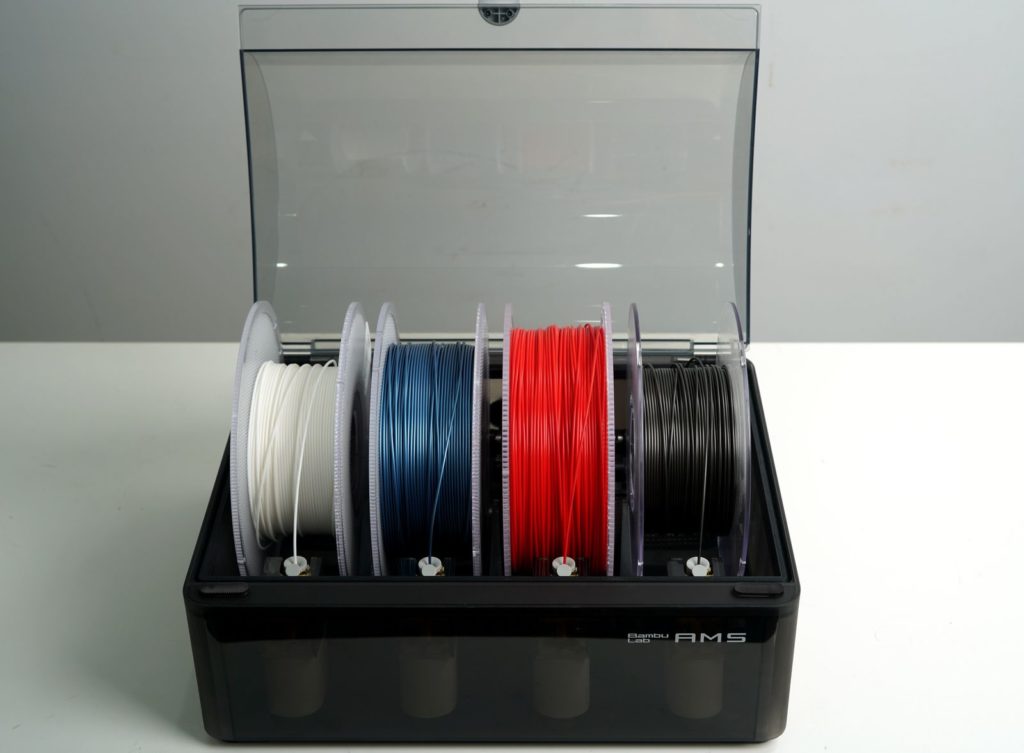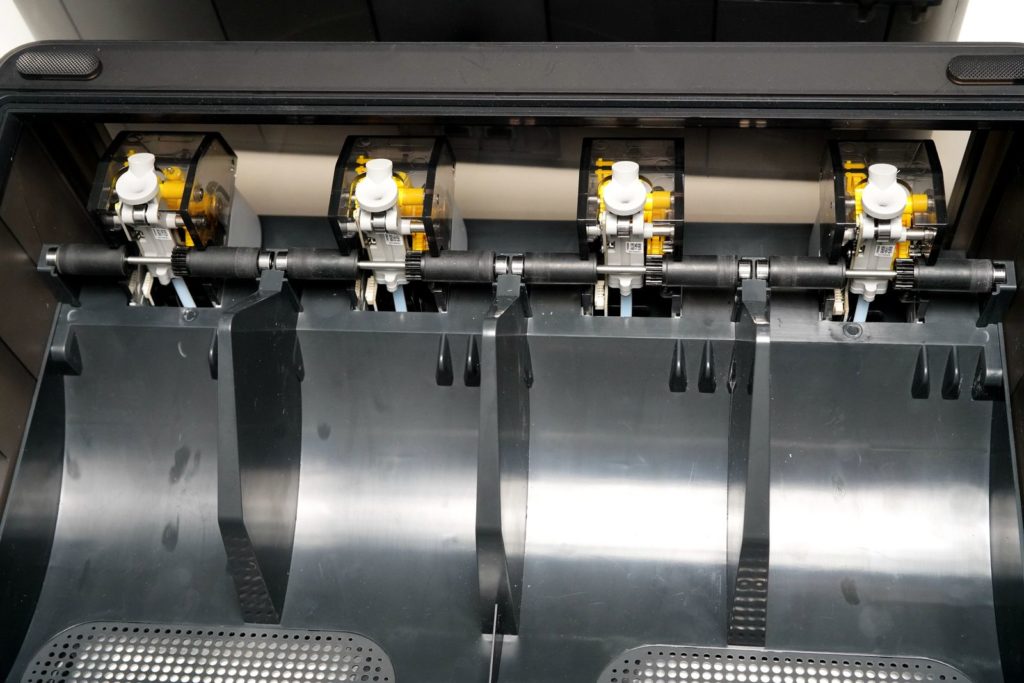I was incredulous when I first saw the Bambu Lab X1 3D printer. A printer with a core XY architecture, it has a material enclosure for four spools of filament. Bambu claims that it can perform material switching, including better support materials and short carbon fiber reinforced polyamide. It is said to have an all-metal hot end capable of reaching 300°C all-metal hot end, a bed capable of 120°C, and a chamber up to 60°C, with 40W ceramic heaters. The company further said that the X1 has AI-powered LIDAR for calibration, as well as a camera within the build chamber, a belt tension sensor, spaghetti detection, and AI first layer detection. The print head can accelerate at 20 meters per second and move at 500 mm per second. There was also something called high bandwidth flow control. The quiet X1 additionally has native 3MF support.
This isn’t a 3D printer. It’s a dream-come-true. What’s more, on Kickstarter the printer was selling for $1,500. What is happening?
The Bambu X1 3D Printer: A Kickstarter Coup
Currently, the Bambu X1 has raised €6,670,950 from 5,560 backers on Kickstarter. This makes it one of the most successful hardware Kickstarters of all time. This would be the biggest 3D printer on the crowdfunding site after the Ankermake and Snapmaker. In addition to running an excellent crowdfunding campaign, the company was also doing great in outreach. All of a sudden, everyone had an opinion on the Bambu Labs X1.
My personal take is that the printer is feature rich and I love many of these features. I wonder about vibration across the chassis and its ability to print larger objects. The “Active Vibration Compensation” system would seem to be integral to its success and difficult to copy. The company is made up of a number of team members who have worked on gimbals, vibration, distortion, and computational physics and modeling. Bambu has an ideal team to build an active method for reducing vibration across the chassis and within the chassis itself. This could be a true USP versus other players in the industry.
If Bambu eventually manages to iron out all of the inevitable initial teething issues, the X1 seems to be a very formidable machine at a low price. It’s not a knock out blow, but it is a body blow to a lot of mid-market players. It will take some time, however, for the firm to tame all of the complexities of this beast and get it to work properly, which will give everyone else time to compete with them.
From Hype to Hype Hangover
From high hype and a great deal of enthusiasm, we are now seeing a bit of a come down for the product. On the one hand, some of the components seem to not be able to withstand the heat required to print polyamide even in initial print runs. This is very worrying because this is simply spec sheet stuff, in which we’d expect any company worth its salt to know the heat deflection temperatures of the components that will be in the heated chamber. That is fixable, but very sloppy. Bambu isn’t the first company that’s done this, but its not a good sign.
Finally trying CF Nylon in the Bambu X1 Carbon. Hot end is jammed, and chamber temps hit 50c, which made cable chain soft enough to come apart. The USB cable inside it is also softer than it should be.
Yikes. pic.twitter.com/3m6OdrPWVd
— Joel Telling – 3D Printing Nerd (@joeltelling) June 29, 2022
We’ve also heard that Bambu’s slicing software uses PrusaSlicer without proper attribution or sharing its code with the public.This is a sign of disrespect to the community as a whole and to open source software generally. It is also not good business practice. The company quickly responded, not with contrition but with a plan. Efficiency is good, but being humble in the face of challenges in mistakes is often a better portend of long-term business success.
🤔I guess this explains why we started getting BambuSlicer entries in our DB shortly after releasing PrusaSlicer 2.4.0 🤭 We introduced opt-in to anonymously send us system info with this version. The Bambu reskin looks nice though 🥸 What are your thoughts on this? 1/2 https://t.co/rDT6PxGtWy pic.twitter.com/9bo598iCS0
— Josef Prusa (@josefprusa) June 29, 2022
There are also some issues that are very worrying generally.
Been in contact with Bambu Lab quite a lot about this and it is a very high concern for them to fix. Already sending me new profiles and they are definitely on top of it. https://t.co/SjbuJttehY
— The 3D Print General (@3DPrintGeneral) June 28, 2022
However, given that this is essentially a pre-release version of the printer, a lot of the technical issues can be ironed out. The company also has a bank of 200 3D printers for testing, which is lovely and should make the printer much better. Bambu Lab has also disclosed that they’ve made at least seven versions of the 3D printer so far.
In an exhaustive video below, Uncle Jessy says he’s sending back his very fast 3D printer.
In the midst of our waves of hype to sorrow, let’s take a step back and look at why the Bambu Labs X1 is important. I am, by no means, the first person to have opined this, but I think that now is a good moment for introspection. Uncle Jessy rightfully describes the product as “a kick in the pants” for the market and has referred to as a game changer by many people.
I echo those sentiments. The jury is still out on if this printer will deliver on its many promises. It could very well fail miserably or dominate the 3D printing market. We will have to wait and see which it will be. But, the Bambu Lab X1 will change the industry. Let’s take a look at how.
The X1 Changes the 3D Printing Market
There are seven major ways that the Bambu Lab printer is changing 3D printing: being different, new feature set, market-based innovation, software forward, excellence across the board, team and funding. These seven major ways that Bambu will change the market are also simultaneously seven things that the company seemed to have gotten right so far.
Being Different
A lot of individuals have pointed this out, but the Bambu Labs machine in-and-of-itself is market changing. It could fail miserably and still be very impactful. The desktop material extrusion market has become quite stratified with high-volume Chinese producers like Anet, Creality, Artillery, and others selling 3D printers for $150 to $400. These were slowly getting better, with more features. Prusa Research continued to manufacture well-made fused filament fabrication systems for $300 to $1000, moving toward bigger machines as well.
Above $1,500, there was a real shakedown in the industry with firms getting crushed. Over this price point, Ultimaker was making $5,000 printers and even better in-office machines for $10,000, where it may or may not bump into Stratasys and its higher-end systems. From $150 to $3,000 most printers had the same architecture and software, differing mostly in terms of component sourcing and price.
The Bambu changed this. It demonstrated that a feature-rich printer with new ideas could make an impact. Everyone is now going back to the drawing board to dream bigger and look at newer features and functionalities to improve their machines. In this sense, the printer has really shaken up the market.
Feature Set

Most often, businesses were claiming to have developed the only reliable open source printer. This was frequently wholly untrue all of the time and sometimes untrue for just some of the time. Features included new displays or filament end detectors.
Bambu has gone much further than this and engineered many more features. Some, like the Automatic Material System (AMS) mean that it can enclose four spools and keep them well-tensioned all of the time using a motor to pull back filament and ten sensors to monitor the process. LIDAR-based calibration and first layer analysis is also new and could be advantageous. AI-based features may very well prove their worth—or they may be mere marketing claims. On-board camera and spaghetti detection should have frankly have been included on all systems a long time ago.
The plethora of features is notable, as is the fact that the company has been working on some of them for over two years. This will inspire a lot of companies to come up with super silly names for stupid features that will not work. At the same time, it may set in motion a desire to really look at ameliorating the daily usage problems of a desktop 3D printer.

Market-Based Innovation
Rather than produce another clone to die in the clone wars, Bambu is clearly trying to eliminate a lot of user issues and problems. There must be a great deal of deep 3D printer usage experience in the firm because a lot of the developments are exactly related to the problems that affect users most. The company has solutions for many issues, some incredibly over-engineered and some elegant. However, they did listen to our problems. They didn’t just make a Prusa copy with a color screen. This will lead to many more companies, hopefully, that listen to users and deal with their complaints.
Software-Forward
It is not really surprising that, at its core, Bambu’s slicing software belongs to someone else. There has been little fundamental innovation in slicing lately. It looks like the firm uses PrusaSlicer without crediting it or giving back to the community. This is a travesty and should be dealt with in a polite and efficient way by the firm.
With app notifications, an iPhone and Android app, and software-driven features they have made a much more software-forward printer. The Bambu leans on software for a lot of its features and experience. So far, 3D printer teams have been made up of a mechanical engineer lead, with innovation resting on the hardware side and software as an afterthought. Formlabs and Markforged are two examples of companies that have beautiful, well-engineered software that really makes the overall experience seamless. Hopefully, Bambu will inspire people to ship better programs that work seamlessly with 3D printers.
Excellence Across the Board
Bambu was great at their Kickstarter and general PR, but also with engaging 3D printing influencers. Indeed, its marketing relies very heavily on influencers. It was omnipresent on YouTube and everyone sang its praises for a while. The firm seems to be capable of very solid engineering and cataloging the problems that users have. There must be some stellar project management going on in getting this complex system to market, as well. At the same time, the team also raised a lot of capital before going to Kickstarter. So, to launch a printer now, you have to be good at many things and excel at marketing to capture attention. Boxes with bad websites will hopefully be replaced by people who communicate better and are striving for excellence across the board.
Team

Bambu’s team consists of ex-DJI engineers. DJI itself came out of nowhere to completely dominate the consumer drone segment. Your local electronics store predominantly stocks DJI drones, wherever you are on the globe. Look around and you’ll see that almost every other electronics segment is more competitive and fragmented.
DJI´s absolute and total dominance of the consumer drone market is an incredible achievement. Drones are also finicky and have to be protected from manhandling and crashes. It’s almost an ideal background to have made complex consumer unmanned aerial vehicles that balanced software, hardware, engines, and more at scale. It’s hard to think of other segments that have the same mutual dependence of interconnected yet disparate systems that 3D printing does. Also, the scale of the business and how globalized DJI has become would really help this team.
Generally I think that this team is an incredible advantage to the firm and will lead to more people looking for stellar engineers as founders. Dr. Ye Tao´s experience as CEO is augmented by project management on the Mavic Pro. Additionally, as former Director of Propulsion Systems and Director of the Consumer at DJI, make him very well placed to oversee the development of a 3D printer.
Funding
Rather than having to risk it all on Kickstarter, this firm previously had some heavy investment. It would seem that it has heavy venture capital backers. This is very reminiscent of Formlabs, which was made up of a well-funded team that used Kickstarter to catapult itself towards users and growth, rather than funding. In this case, Kickstarter worked like a charm, but the company was practically manufacturing-ready with, it seems, all major molds and components already made. Perhaps the company is funded by SIIC, a very well-connected firm. However, there may be others as well. This means that the business should have significantly more heft to scale operations internationally and increase the capabilities of the printer.
Conclusion
Whether the initial success of the Bambu is far from certain, the company seems formidable and they’ve made a printer with a lot of features and capabilities. The firm is very ambitious, seems to be well-funded and is on a path to disrupt the 3D printing industry. Bambu Labs has changed our industry and is a serious potential competitor over time to any and all 3D printing businesses.
Subscribe to Our Email Newsletter
Stay up-to-date on all the latest news from the 3D printing industry and receive information and offers from third party vendors.
Print Services
Upload your 3D Models and get them printed quickly and efficiently.
You May Also Like
Johns Hopkins University Researchers Develop HyFAM Technology
Two scientists from Johns Hopkins University, Nathan C. Brown and Jochen Mueller, have developed a hybrid manufacturing technology they call HyFam, or Hybrid Formative Additive Manufacturing. Their work on this technology...
3D Printing G-Code Gets an Upgrade: T-Code
Good old G-Code still manages many 3D printers, great and small. Just like the STL, it’s a standard that enables collaboration while also holding the additive manufacturing (AM) industry back....
AM Rewind: The Biggest News and Trends of 2024
After a sluggish 2023, driven by persistent inflation and geopolitical tensions, 2024 has seen some recovery. Economic growth climbed from about 2.8 percent in 2023 to a modest 3.2 percent...
Metal Wire 3D Printer OEM ValCUN Announces Plans for 2025 Expansion
ValCUN, a Belgian original equipment manufacturer (OEM) of wire-based metal additive manufacturing (AM) hardware, has announced that the company has entered the next phase of its growth trajectory, making key...

































